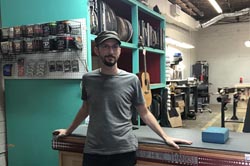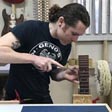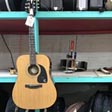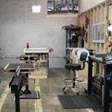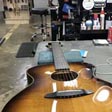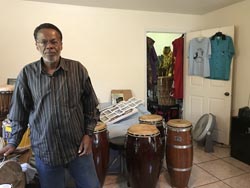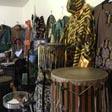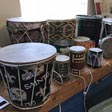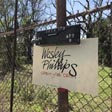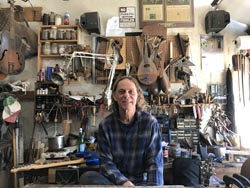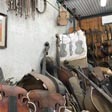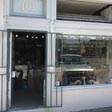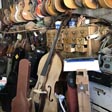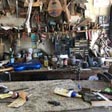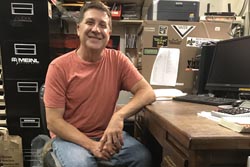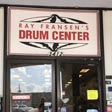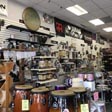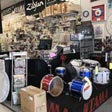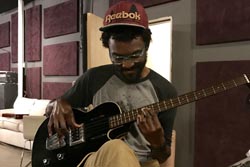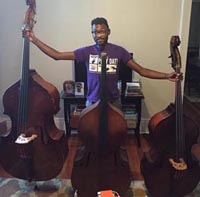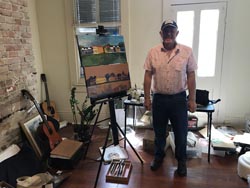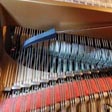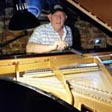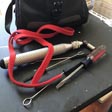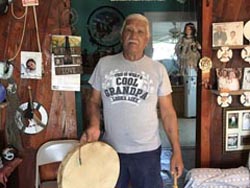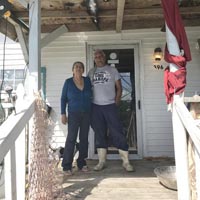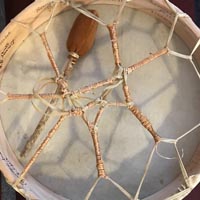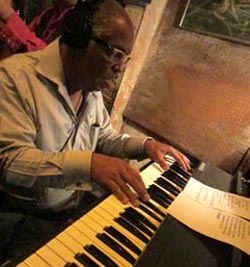Innovation, Tradition, and Change in Louisiana Musical Instrument Making and Repair
By Holly Hobbs

Southeast Louisiana
Benjamin Strange and Aaron Younce, Guitar building/repair/shop owners
Strange GuitarWorks is the music shop of guitar repairer Benjamin Strange. Located at 1122 Dublin Street off Oak Street in uptown New Orleans, the shop is more workshop than music store, although they do sell guitar strings and also sell their custom guitars out of the shop (although most of their custom guitar sales happen online). The majority of their business is comprised of walk-ins—people who come in with issues with their guitars that need to be addressed.
Benjamin Strange hired Aaron Younce a few years ago to join the business. Aaron does the majority of guitar building, while Benjamin focuses largely on repair. The music shop has a front desk to service walk-ins, but largely looks like a workshop. The two service a high number of guitars and reported that 2018 is their busiest year yet.
Benjamin Strange came to New Orleans decades ago, drawn to the city's thriving music scene. He worked at the famed Werlein's music store in New Orleans, gaining an introduction to both guitar repair and the role of the music store in the local community. Over his time at Werlein's, he witnessed the slow decline of the store, which left him with a desire to find a way to create a music shop himself that would be both resilient and stand the test of time. He began by creating a small workshop in his house. After finding success with his extended community of friends and fellow players, he opened his own repair shop in 2013.
Both Benjamin and Aaron focus on fret work, as they say this is the most integral part of creating the desired sound in a guitar. Benjamin says what makes his work individual to him is that he chooses to focus on scientific perfection rather than an aesthetic feeling, and that with precision, one could derive a perfect sound. Both Benjamin and Aaron apprenticed at guitar repair and building shops on both coasts before relocating to New Orleans, but Benjamin said much of what they do is trial by error—they understand the process through their apprenticeships, but over time have developed their own methods to address existing problems. Aaron's father was a guitar builder, and he began from an early age to apprentice with him.
He discusses the role of the music store in great detail, and what it takes to keep a music shop in business when Internet competition is so intense. Because, they say, they have developed strong community support over time due to the strength of their work, both Aaron and Ben state that they do no standard marketing: all advertising they do is on social media. Ben talks about how the store functions in the community:
Our shop is like a barber shop. It's kind of grown to where there's a lot of people we've become friends with, sometimes they'll tell us their life stories, people come in here and they're just comfortable. We're fixing their guitars but there's also a little bit of therapy involved. There might have even been some bands formed in here. Ultimately, I think we're a service to the community and we always want to be that.
Aaron continues:
People don't need music stores anymore because of the Internet. . . . The role of the music store now is more of a personal thing, a social thing. . . . The music store is a more visceral experience than online retailers and people appreciated the ability to go in and actually talk to somebody. That's important in New Orleans.
When asked whether there's a cyclical arc over time, and perhaps that brick and mortar music stores will return after people have grown tired of the lack of in-person interaction and community, Ben responds, simply, "No." Even though Strange GuitarWorks functions very much as a music shop, and they do sell strings and other small goods, they view their store exclusively as a repair shop, and see a large difference between that and the standard music store. "You couldn't pay me enough to start a music shop now," Benjamin emphasizes, continuing, "It just seems like a recipe for disaster. It's becoming obsolete."
Both makers purchase many specialized tools for their work, but if they can't find what they need they either build their own tools or adapt existing ones to better fit their needs. Benjamin concludes that, "anything can be fixed." Throw-away culture and a consumer society, they conclude, is what they feel their work is acting directly against.

Wesley Phillips, West African diasporic drum building/repair
Drum maker Wesley Phillips's music workshop is located on Robertson Street in the 7th Ward of New Orleans. Mr. Phillips lives around the corner from his shop and gets walk-ins from people hearing about him via word of mouth, or from those who see his artfully hand-painted sign that says "Wesley Phillips: Spirit of the Drum" hanging on the gate, but the studio is primarily his private workspace and he handles clients by appointment only. His workshop is filled with drums he uses for performance, drums he has made with traditional animal skins, and costumes he's designed for Mardi Gras Indian and West African drummers and percussion ensembles, which are displayed on the wall. On his workbench sit a number of drums that he's currently developing for a proposed children's workshop for the New Orleans Tricentennial, where he plans to teach 300 children to make three different goatskin drums that represent each century of New Orleans history (1700s Congo Square, 1800s military drum, and 1900s jazz and second line drums, each decorated with fabric that he chose as indicative of each era). One byproduct of this project, Mr. Phillips says, is "to teach kids that you don't have to buy things, and plus it'll be recycling using metal cans, coffee cans, food cans, scraps of fabric, so this is a project to repurpose items into a tunable drum."
Mr. Phillips grew up in the 7th ward of New Orleans, then moved to the Desire Housing project in the 9th ward with his family, and then back to the 7th ward in the early 1990s, which was when he first started performing on the drums with West African drumming ensembles, and later, with Mardi Gras Indian tribes. There were many musicians in his family growing up: his brothers played guitar and saxophone, his sister was a gospel singer, and his mother sang. Mr. Phillips played with his guitarist brother in a rhythm and blues group. When asked what it was about the drums that first captivated him, he responds that, "the sound of the drum in New Orleans means something is about to happen." The drum has a central importance in New Orleans, Mr. Phillips continues, going back to Congo Square. He had wanted to play piano as a child as well but never got the opportunity: he loves everything percussive.
In the early 1990s, he began playing the djembe with Pan-Africanist groups and built his first drum in 1991. He was taught by others in his West African drumming ensemble to change the drum skins and to better understand how to work with the roping system that connects the skin to the drum. He began by making bass drums out of metal cans, then later began working with oil barrels. From there, he worked with Sacred Dance Ministry (a Catholic African drum group) and began running drum workshops teaching others how to make drums and began selling them to other drummers in the region. He had an apprentice at that time who was a Mardi Gras Indian sewer, and he began playing with the Indians, establishing drum sections for a number of different tribes so they could play together. He began sewing his own costumes for the drummers to wear while performing, all reflecting the West African diasporic aesthetics that inspired him. One of Mr. Phillips' most important contributions to his community was his re-introduction of animal skin drums back into Mardi Gras Indian tribes, who had long ago switched to plastic tambourines. In addition, he contributed to the formation of drum ensembles within Mardi Gras Indian performance, allowing tribes to perform in more elaborate ways than with the tambourine alone. He continues:
After we moved from up here in this area [7th ward], this is one of the main areas for the Yellow Pocahontas and Tootie Montana, we would come here as kids, either the night before, and you would hear tambourines. . . . This is one of the main [parading] areas they would pass. And even before then, you would hear the Skeletons [parading tribe] coming out, and then people say, "the Skeletons coming" and everybody hide, get in the bed, get in the closets. But the Skeletons was knocking on doors, waking people up, and as a child you didn't know who these people was, they looked like Martians with big paper mache heads. . . . They'd go to the butcher and get the bones with the meat and blood dripping, . . . so the Indians would follow them.
First you'd hear in the distance the little jingle of the tambourines, and you'd start hearing the songs and the voices and stuff. But I didn't really get into the Indian culture . . . because mostly we'd go to Canal Street for Mardi Gras. We didn't stay in the neighborhood. . . . So my great aunt, she remained here after we moved into the Desire [Housing] Project, so we'd always come up summers or different times, but I didn't really know anyone who masked in the area until I moved back here in 1991.
Well, I started playing one day, one Mardi Gras, so after that they'd say, "come get the drummer," so they'd come get me for the different events, for Super Sunday and stuff. So from there it just became a regular thing and then once I started making drums and the costumes, I sort of became dedicated to establishing . . . --because that was never done before--a drum section, you know, playing with the Indians, and then the fact that we had matching outfits, it kinda created a whole new thing. And then plus the drums created a whole different sound.
See, most of the Indians was going to the bass drum, you know, the regular marching band drum, and then with these drums, with the cow skin and the goat skin, it just gave it a whole different sound, sound effect. And everybody would know us because they would hear them drums, the sound would travel far.
They have an African proverb that says a dead animal screams louder than a live one, which means, you know, a goat could make a sound and it could be heard within a particular area, but once that animal died and you stretched that skin and make a drum, you could send a message from village to village and it could spread throughout the whole countryside, throughout the whole continent. So the drum is a very powerful instrument in terms of it mimics the human voice. . . . The drum is a very communicative instrument.
Mr. Phillips continues:
Yeah, I would say basically around that time it wasn't using the animal skin drum. Now see, the Mardi Gras Indians referred to the tambourine as their drum. And it's basically the same concept because you got a wooden shell and an animal skin stretched across it. The marching bass drum came in once the Wild Magnolias started recording and they was using the bands and stuff, then went to the big bass drum with the plastic skin on it. So the animal skin really changed that sound.
Mr. Phillips was a government employee for 30 years, a job that allowed him a sustainable income as well as an ability to travel and work with different drumming groups. It was in this way that he found an animal skin seller in Tennessee, from whom he now gets his skins, since he can no longer find anyone locally near New Orleans to get them from. When asked about his aesthetics in instrument building, and the process by which he makes his drums, he states:
I'm aiming for the sound I want, but it goes deeper than that. The act of making drums is a spiritual thing within itself because the drum maker goes into the drum. When you play a drum it's going to express you, what's inside you gonna come out in the drums, that's that spirit of connection. . . . When someone in New Orleans plays the drum, they want to be free.

Sal Giardina, Stringed instrument building/repair/shop owner
Sal Giardina is the owner of Stringed Instruments Restoration, a stringed instrument repair shop located at 101 Focis Street in Metairie outside New Orleans. The modest entrance leads into a small workspace packed to the ceiling with instruments, some old, some new, most in some state of restoration or building. Sal's first built instrument was the double bass, although he has also built mandolins, ukuleles, guitars, and a number of other instruments since. It has been his life's goal to begin building violins, and he wants to devote himself to learning to do so in the coming years. Giardina says that because of his location, he gets a high number of walk-in clients. He markets himself primarily by word of mouth and via his website. His son, Nicolo, works in the shop as his apprentice.
Sal Giardina comes from a Sicilian family and grew up on the West Bank of New Orleans. His first instrument was guitar, followed by electric bass. He joined bands as a teenager, playing rhythm and blues on Bourbon Street and throughout the city. It was at this time that he got his first job at a violin repair shop on Magazine Street owned by a German-born luthier. He apprenticed at the shop for years, starting with simply sweeping and keeping the shop clean, followed by actual apprentice work learning stringed instrument repair from the owner, a master builder himself. Eventually, he opened his own stringed instrument building and repair shop in his house. He worked via this home shop for many years, finally moving into his own store in Metairie.
His son, Nicolo, speaks about being his father's apprentice from the time he was old enough to walk, learning different instruments and tools at his father's side. He works part-time in the store, assisting in repair work that Sal himself is often too busy to do. Sal Giardina references his classical apprenticeship learning process, often returning to the theme of the great European classical builders and their work processes and building aesthetics, much of which, he feels, has been lost to time.
Giardina's father worked with his hands, and Sal grew up doing the same, taking things apart and putting them back together to see how they best fit. He notes that there is a careful balance between form and function, noting that one must have a balanced combination of both to achieve the perfect sound. He defines his aesthetics as classic, noting that he aims for longevity in his work, attempting to create pieces that will stand the test of time. An instrument must have beauty, he says, but also function as best it can for the player. He is proud of his scroll work and says this is his defining mark on an instrument.
Giardina speaks of the old ways often, and many of his choices in building style and materials reflect this aesthetic. Instead of the modern varnish used by many builders today, Giardina uses Everclear, noting that it is healthier, has no toxic fumes, and is far more natural than the other options. Passion for his work is evident throughout the interview. He notes that creating and fixing things to improve their sound has been a central passion of his as early as he can remember.
He discusses the role of the music shop and what it takes to maintain a business successfully. His stringed instrument repair shop does sell strings to customers, but it functions as a building and repair shop exclusively, rather than a standard music store. He elaborates:
There's no such thing as perfect. I mess up all the time. You can strive for perfect and not get anything done. This is an expensive place to run, this is not a cheap area. The materials are very expensive. Because of the amount of money it costs just to live now, it's harder being an artist. In other words, you almost have to be super business oriented, and that's where [Nicolo] comes in. . . . I'm not into marketing, okay, as you can see. But you have to be. Because you can't survive. This is an Old World craft that you're trying to do in this. We charge a fair price [to our customers]. You gotta remember, we're working with musicians. I've been a musician in this city, I know what it's like to try to make a living playing music in this city. I mean, you don't rip someone like that off, okay? My customers . . . have been with me for thirty, forty years, some of them.
On the role of the Internet, Giardina states:
If you get [an instrument] from the Internet, you still have to come to me and get it set up right. You know, so that doesn't hurt me. What hurts me is the fact that so many people are trying to do [luthier work] right now, and people are recommending other people. Some of it is just politics, . . . but if you pull my name up on the website, I have really good reviews. If I had five people over the years that weren't satisfied, they were people that you couldn't satisfy anyway. The work that I get is the work that nobody else can do. You know. And all these other people, they'll take work that's really easy, and they'll use the word luthier. And once again, I'm not a repairman. The [German builder he apprenticed with] used to say, you're not a repairman, you're a restorateur. I'm not a carpenter, I'm a restorer.

Frank D'Arcangelo, Drum repair/drum shop manager
Since the 1980s,Frank D'Arcangelo has been a manager, drum salesman, and drum repairman at Ray Fransen's Drum Center, located at 3412 Williams Boulevard in Kenner outside of New Orleans. Frank offers the perspective of a person who has worked in a music store over a long period of time, rather than owning the store (although he takes on many of the responsibilities of an owner). Ray Fransen's is one of two stores in the state, to his knowledge, dedicated solely to drums, and it has remained open for decades, even though the store moved to a new location after Hurricane Katrina. Frank D'Arcangelo discusses his work and the changes that he's seen over time.
Frank D'Arcangelo was born and raised in Metairie. There were no musicians in his family, but he was drawn to drums from an early age, beginning drum lessons at 8 years old. He was inspired by his school band teacher and played in a few small bands growing up. In the early 1980s, he began taking lessons from Ray Fransen, who eventually offered him a job in 1983 at the newly opened Ray Fransen's Drum Center. He has worked there ever since.
From the beginning, Frank says, Ray Fransen's was a successful business, owing much to the fact that it was unique as a drum-centered store and offered a huge assortment of inventory. He began teaching himself to repair drums, mostly through trial and error on a necessity basis. Still today, he notes, much of the repair work they do is virtually free for customers, included in the price of what they purchase, and sometimes, for walk-ins as well. D'Arcangelo has a small home workshop as well, and when a repair job requires too much work for the store, he takes the instrument home with him to repair.
Ray Fransen's has long been a resource and trusted community space for New Orleans musicians. Frank elaborates on the changes he's seen over time:
There's less volume [of business and inventory now]. And that's not just this business, it's every business. If you talk to anyone in business today, it's just the fundamental distribution of goods in this country has changed. I think everyone in business, other than food, will probably tell you that their business is suffering because of it. But I still have people that come here. And I still have people that bring their bass drum pedal— "I've got a gig in an hour, can you fix this?"—you know, or if it's unfixable, get them something different. I mean, we still have business, but it's not what it used to be. That's just the nature of what's happening in this country today.
He expresses concern about the store staying in business.
This store's surviving, it's doing enough to stay open, but nobody's getting rich over here [laughs]. . . . The Internet has been the biggest factor. From a purely retail standpoint, yes, that is a huge thing. But from an educational standpoint, it's unbelievable. I tell these kids that come in here every day, you have no excuse but to be good. It used to take me six months what you could find in two minutes on your phone. To watch somebody do something and explain it to you.
When asked whether there's a cyclical arc, Frank replies, "No. Honestly, no. It's too easy for people. People want their free time." He continues:
I'm trying not to be cynical about it, but I come here every day trying to do the best that I can. And learn something, I learn something every day, no question about it. But I try to treat people like I want to be treated. And it seems to work. And I just find that if you treat people properly, they're going to come back. But I understand that people are going to search out the best price, even though we're competitive, it's the convenience. . . . [The impact of the Internet] hampers your ability to invest in drum sets and cymbals. Our success has been that you can look at every category in this store, and we've tried to have a variety, so much more than anyone in this area has ever had. And I think that's been true. Like, we carry more drumsticks than anyone around here. I mean, I probably have 350 kinds of drumsticks in there, we call it the Wall of Confusion because it just, I mean, you go look up there and it's insane, but there's something for everyone. But it makes it hard to stock that, it's a lot of money.
So as the business has a declined a bit because of the Internet, it forces us to not to do what we wanted to do, to offer as much variety to people as possible. . . . The thing that's affected most is expensive items: cymbals, drum sets. You know, we used to take some chances on stuff. You can't do that anymore. And I think that's unfortunate. Because that was kind of the mission. To have something for . . . so much variety that an artist could select. They could feel it, touch it, smell it. There's nothing like playing a cymbal. There's nothing like picking up a drumstick and trying it out. You can order it and get it for 50 cents cheaper, but when you get it home, do you really like it? Is it the perfect implement for you? You won't know that until you try it. And that's something that we've always tried to do.

Charles Lumar, Double bass building/repair
Charles Lumar is a New Orleans-based electric bass and double bass player who is learning to build double basses. Now he spends much of his year touring with vocalist Solange Knowles as one of her band members. He discusses his journey to the upright bass and his learning process of building and repairing stringed instruments.
Charles was born in St. Charles Parish. There were no musicians that he knew of in his immediate family, but from a young age he was drawn to music-making. He began on the tuba in 5th grade, started playing electric bass in 11th grade with a high school jazz band, and eventually got a scholarship to Loyola University in tuba performance. Back in high school, he had found an old double bass in his school's band closet and asked to take it home with him. The bass was in poor condition, and Charles set about to try to fix it. From that point on, he became increasingly fascinated with the double bass, teaching himself how they worked and how to perfect the sound he desired. That led him to an apprenticeship at Keller Strings music store in New Orleans, where he began learning all facets of stringed instrument repair. His apprenticeship with a double bass builder in North Carolina continued his education, and from there he knew that it was a passion he sought to pursue.
Double bass resources are scarce in New Orleans, he says, and with the Internet today some things are easier, but he wonders how double bass players survived in the past with so few players and resources dedicated to them. He continues:
[The builder he apprenticed with was] not a traditionalist. And that's what I think is a lot of problems with the string repair world, you do things how they've been done. I ran into that a little at Keller. And things are just done differently sometimes on bass. . . . I'll say this, for bass, [adaptation and innovation] is already happening.
I don't know if I'm tuned in enough to the other three, violin, viola, cello, but for bass it's just like, simply, the act of traveling with a bass. If you're famous, or even not, if you're making a living as a touring bassist, or if you're in the LA Philharmonic or whatever, those orchestras go on tour, soloists from this jazz group go on tour, or cats with this jazz group go on tour, or cats from Nashville with this group go on tour. . . . Everybody's on tour. And you don't want a new bass in every new city. When I was on tour, we were doing some stuff that I was doing upright [bass] on and it was just, whatever the dude brought, because we didn't travel with upright bass. It's very hard. And it's just one more thing to think about. It's doable, cats have done it, it's not, like, woe is me. But it's better to do it on your own instrument.
So there used to be, people were making these kind of travel basses initially. Sometimes they were making, like, these skinnier bodies, shallower bodies, sometimes they started making them shorter, like the same width and depth but just shorter, all just to make it less of a big thing, right? And those were kind of the earlier things.
And so the quality of sound and the experience of playing it was still there. . . . And then these cats started doing this whole removable neck. And this circles back to the tradition of it because the neck is just a joint. And I've heard it argued that if the neck is cut properly and fit properly, you don't even need any type of glue. Just the sheer forces at play on the instrument will keep it there. . . . So cats just started to experiment . . . and even super old, like 300-year-old instruments, the owners are more amenable to having this crazy procedure done on it than to have an airline carry it. So I feel like transportation has really caused the most innovation in bass.
The central question, Charles says, is how do you know that something new won't work the same or better? Innovation is key to maintaining tradition. Charles continues:
The future of bass is exciting. If we talk again hopefully in some amount of years, it'll be like, yeah, Charles has this little shop that he's out of when he's in town, it's a resource center for bass instruments: repair or rental or purchase or lessons. Ultimately, the goal of all of this stuff for me—repair, even, like, playing better and teaching—there's an absence of resources that are bass specific.
You will find that to be true in a lot of places, unless they're just fortunate enough to have some type of bass situation set up. . . . The goal has to be to elevate the options and the information flow for the community of bass playing people and their families. I could always sell somebody something, but that's pointless to me because people don't need to be sold things, people need to be educated.

Henry Artigue, Piano repair
Henry Artigue has been a piano repairman in New Orleans for decades and is currently the exclusive piano tuner for Preservation Hall. He talks about his work and the changes he has witnessed over time.
Henry Artigue grew up in the 9th Ward of New Orleans, attending the same school as the Ruby Bridges school integration (he was there that day and remembers it well). Henry Artigue is an interesting inclusion, because his choice of piano repair as a profession was in some ways more of an economic one than an artistic one, although he quickly grew to find joy in his life's work. Nonetheless, his first love—from the time that he can remember—was sound. He explains how he came to the piano:
I had a guitar when I was 15, that was 1966 or so, and everyone wanted to be a rock 'n' roll musician. . . . I was working in a garden center making $2.50 an hour, 10-hour days . . . and I kind of got turned on to the piano. I bought this old piano from my mother's church and I thought I'd found Chopin's lost piano. . . . It was just an old clunker.
So I had a young tuner come out and I took off work to meet him, it took him about an hour and he charged me $25, which was my day's pay for working outside real hard all day. . . . I asked him, you know, how can I get into that? And there was a correspondence course that I bought and it kind of taught me the stuff I needed to know, it was kind of the encyclopedia of piano tuning and repair of the time. He helped me a bit, but he moved after that.
But I started going to the Piano Technicians Guild, and each big city has a chapter, . . . so I started going to those and hanging around. Most of the guys were old and kind of snobby, it was hard to kind of get friendly with them. . . . It was mostly white guys, there one or two African Americans. Rickie Monie over at Preservation Hall apprenticed with one of them. We don't have any right now. It's kind of hard to get into because you have to learn it from somebody.
You can learn about it, but I have young people come with me and sit and listen, like I did, I went with my guy. I met him at the Piano Technicians Guild and he kind of took mercy on me and said let me help you. He was a jazz pianist down in the quarter, and I was waiting tables at Brennan's.
We'd both get off about the same time, midnight, there was a big store out in Metairie at the time named Grunwald's, and we'd go out there, they had a big warehouse, it was 1, 2 in the morning and he'd go over in one corner and I'd go in another and we'd tune pianos. He'd come over and hear me and kind of show me and I'd go home and practice and starting getting, like, you know, you'd meet somebody and go, "Can I tune your piano? I'll do it for free, just let me do it." A lot of that.
At that time, a lot of music stores offered a free piano tuning with the purchase of a piano, and Henry Artigue began in this way to build up a customer base. He spent the next decades developing a lengthy client roster, but that was interrupted by Hurricane Katrina. When Artigue returned after the storm, he found he had to start over to build his client base back to where he was. Over the decades of his work, he has tuned for countless piano legends who have toured through New Orleans and is now the tuner/repairer for Preservation Hall as well as one of the primary tuners for Jazz Fest, French Quarter Fest, and the riverboats.
Precision is his goal, he says of his work, and it is satisfying when he can achieve the sound he desires. He often refuses to work on an instrument if they are in too poor of condition, as with so many of the flooded pianos post-Katrina. He worries about the decline in piano sales in the last few decades, although he says the majority of the French Quarter clubs he still tunes for have still maintained their old pianos, rather than going to digital.
He describes what he loves about sound:
I hear that in tuning. I play a note and you can hear, in some pianos, it's exciting. I like sound. I was at French Quarter Fest doing the Jackson Square piano and the cathedral bells started going off. They have a nice big round sound. But at the same time the leaf blower was going over here on Chartres Street and at the same time the garbage truck [makes sound] and the train was [makes sound] and it was kind of a cacophony of sound. It's kind of a curse because I hear. . . . I have too good of hearing. I wish I could turn it off when I would like to. . . . I have to live with, it's kind of curse, a little bit. I've taught myself to listen, especially for things that normal people don't hear.

Raymond Reyes, First Nation drum maker
First Nation traditional drum maker, Raymond Reyes, lives near Port Sulphur, Louisiana, in an area called Grand Bayou Indian Village. The Native people who reside in this area live on the bayou and access their homes via boat to and from the mainland. He and his wife, Betty, discuss the water diversion the state has planned for the area, which will mean they will likely be forced from their home within a few years. He talks of his upbringing, drum making, and the changes in the natural environment over time.
In his 70s now, Raymond Reyes was born in Charity Hospital in New Orleans to a Filipino father and Houma mother. There were 11 children in his family, and they grew up in the same area he and his wife now reside. Mr. Reyes was a tugboat captain for four decades, and now in his semi-retirement, does seasonal trawling. After the BP Oil Spill in 2010, he got work in cleanup, which was lucrative for him. He talks in detail about the changes to the area after Katrina and after the oil spill, along with the fresh water diversion that the state has planned in the coming years, which Mr. Reyes says will kill the shrimp and oysters and raise the water line. There have been massive changes to the environment, water and aquatic life over the course of his 70 years, he says—much of the area today is unrecognizable to what it used to be. They are concerned but also feel helpless: they repeat often that it's impossible to fight the government, and simply prepare to take what comes.
Mr. Reyes started making his traditional Native drums later in life. Now he sells his drums for about $50 each, and also holds workshops and teaches children drum making both in his area and at pow-wows. His drums sit in his local church, where they are played on church days. Mr. Reyes elaborates:
I got involved making [drums because community leaders in his area] wanted to make it, and they wanted somebody to make it. I just looked and watched what they were doing, and within 20 minutes I can do it. But I believe I want to try to make it different, to make it sound better. But see this drum, see how it got like that, I believe if you make two holes right here, it would be less thing back here, you know, I mean it would sound better. So next one I make, I'm gonna try on my own and make it the way I want.
"It's just hard to get the skin," Betty says.
Yeah, the hard part is getting that. [The elk skin for the drums] comes from Alaska. . . . [A lady] we order from and she brings it. We were trying deer skin, it's good but it tear too easy. You want something like this, like elk, and it's good, you know. This is the sinew, we just cut through strip and make that there. . . . [For the design] you see what you do, you put it tight as you could, you know, and then when you tie this right here, make it tighter, and then when it dry up, you make it even more tighter, and you have that sound, you know.
The insides of his drums feature intricate designs, laced with feathers that he gets from dreamcatchers and repurposes for his instruments. He and his wife started attending pow-wows both locally and across the U.S. years ago, which was another thing that led him on the path of making drums. Their favorite pow-wow is in Las Vegas, Betty says, but Raymond says he doesn't like to travel that far. The pow-wows are their main social activity and working on the drums has allowed Raymond a creative outlet both within the pow-wow system and within his own community.

Rickie Monie, Piano repair
Pianist and piano repairer Rickie Monie was a member of the famed Olympia Brass Band prior to joining the Preservation Hall Jazz Band as a pianist. He has performed at the Hall since the 1980s and maintains a demanding performance schedule. In his youth, he apprenticed with an African American New Orleans piano repairman to learn the art of repair. He talks about his own early experiences and the New Orleans piano tradition in general.
Rickie Monie grew up in the upper 9th ward of New Orleans, on Piety Street. His mother and father both played piano, and he studied with his father prior to taking formal lessons. His father's favorite ballad to play, Monie remembers, was "Body and Soul." He started on clarinet in elementary school, and that continued through his tenure at Dillard University, where he majored in woodwinds.
Mr. Monie remembers his parents' piano tuner, Mr. Milton, coming to the house, and Rickie watched intently and listened. He had always been interested in mechanical things, taking things apart and putting them back together, and first started learning the art of piano repair through Mr. Milton. He discusses:
I watched my daddy try to fix watches. And I tried with some of the old watches he acquired. I became interested very much in piano repair when the piano tuner came to the house and tuned the piano. I'd sit there and watch him. And one time he had to pull an action, because it needed to be changed and some things he couldn't get to, and the pin that held one of the hammers in place, it started coming out one end. So he started taking that stuff loose and I said, "wow, look at all these parts, man."
I was on a high looking at all these parts and the way they move and everything. And so I asked Mr. Milton, Archie Milton, he was a graduate of Xavier University, and he was a woodwind major also, and he used to give me some pointers on woodwinds, he played oboe, but he also played all the rest of the woodwinds. And I asked him, I said, "Man, how do you know where all these parts go? How do you know what to do and when you tune a piano, what are you doing?" He had these felts and these little rubber mutes, I know what they are now but then I didn't know, it was just a bunch of toys I was interested in, as far as I was concerned.
And this cute little box, little brown box and a little wheel would turn. A guy my age, and I'm looking at this stuff, man, it's got me all pumped up. And so he let me sit there and watch him and I became interested in it. And when I got older, he tuned our pianos for years, I began to work with him and learn some of the things he could teach me.
Mr. Monie is still in touch with Mr. Milton, who relocated to Houston before Hurricane Katrina in search of better opportunities. Rickie notes that there are no working African American or Creole piano tuners/repairers that he knows of in New Orleans. Even though he apprenticed and learned the art of piano tuning in detail, Rickie says:
I kind of like to get things done correctly, but in a hurried manner. So the piano tuning thing was a little bit too slow for me. I'd rather do a repair, I've done lots of repairs on pianos at Preservation Hall, emergency stuff, but tuning, I was a bit too slow at it. I guess if I'd stayed with it, I could have become more efficient.
And now, I don't think I'll be able to do it because my hearing is not good . . . playing in a band, my right ear is shot. . . . Even now, I work on my own piano, and I do some spot tuning, you know, I bring it back up. . . . Henry Artigue is my piano tuner, he's a great guy. Other than that, I keep it up myself.
Piano tuning has gone more digital, he notes, and so much can now be done on an app on a cell phone. He talks more on New Orleans piano traditions.
Everything's electronic now. You buy an electric piano, you plug it into a wall, you never need a tuner, you hardly ever need a tech to come out and do anything. I play one at one of the churches I play for, they just got rid of a grand piano. . . . So everything is getting to be electronic. There's not too many people that's into the intricacies and workings of the old pianos.
You know, I like old stuff. If you ever come to my house, I have a 1956 [Yamaha] B3. My Steinway piano is a 1941 that I had completely restored and it still has all the ivory keys, it's a great sounding piano. It has an upper register that some 9-footers wish they had.



